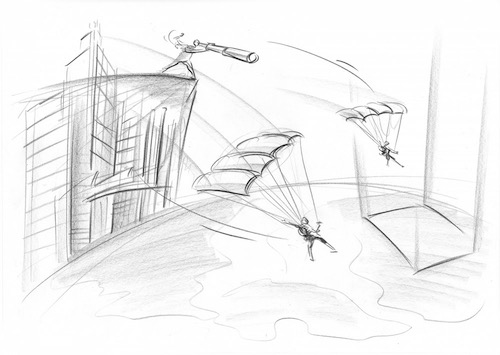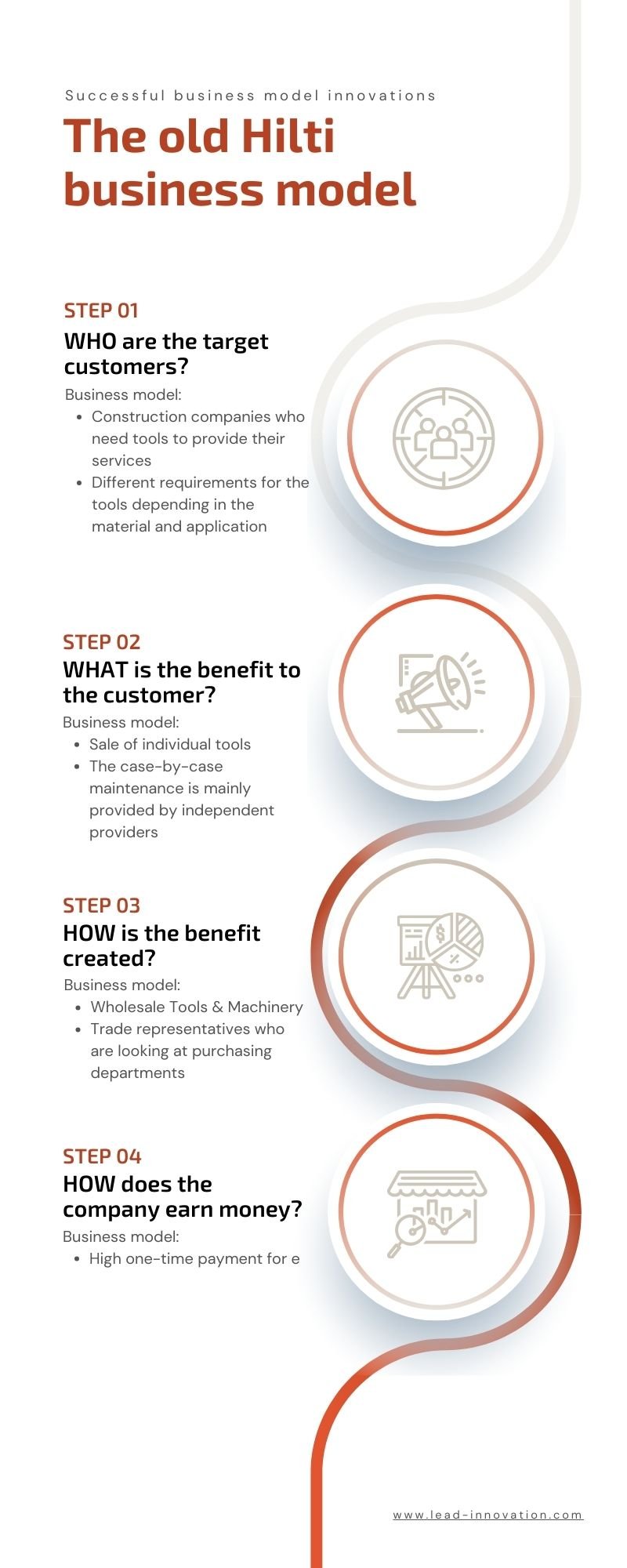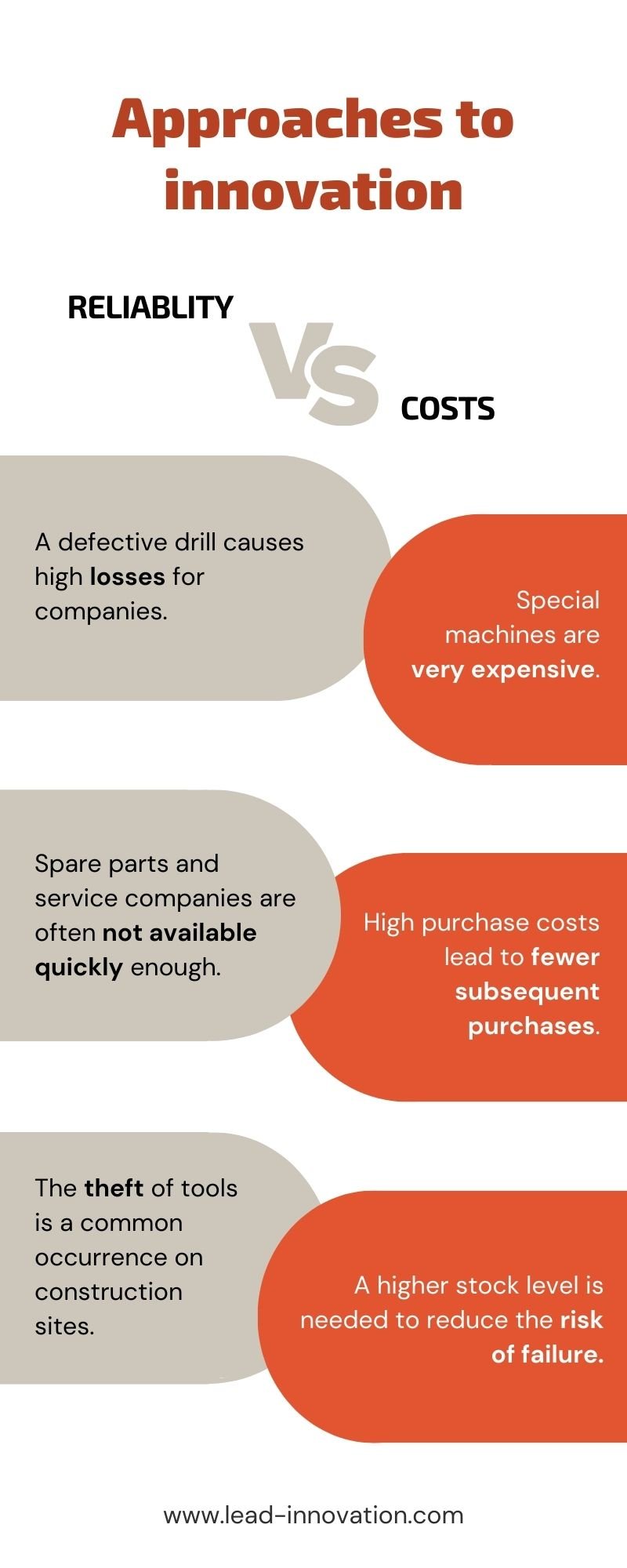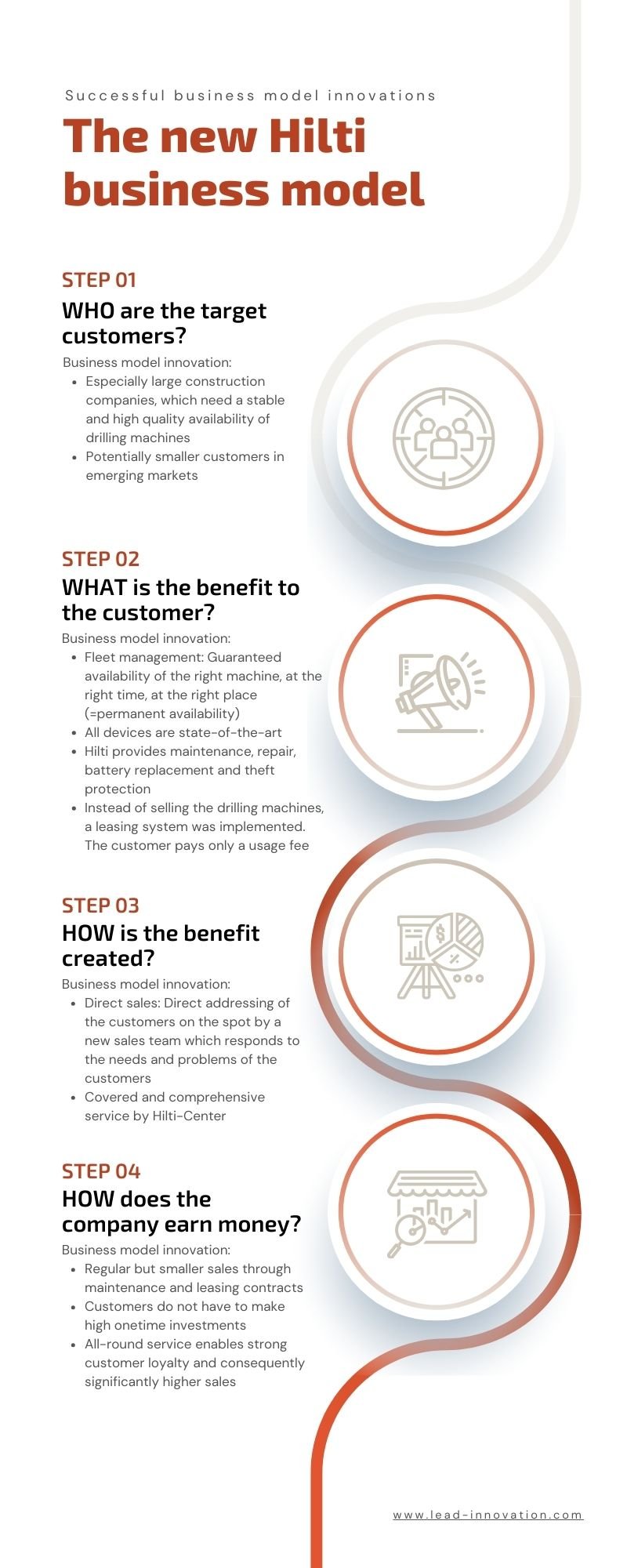What is a business model innovation?
For companies in all industries, innovation is immensely important. In many cases, however, innovation is only associated with new, innovative products or technical renewals. However, business model innovations are significantly more profitable. What a business model innovation is and how Hilti and Apple have implemented it, you will learn in this blog post.

The business model as a starting point for innovation
A business model is nothing more than a model, holistic description of the logical contexts how a company generates value for its customers and itself. The detailed illustration of this logic makes the business model visible, assessable and subsequently changeable.
The business model of a company is thus an analytical unit to systematically identify the starting point for innovation, which means that companies can change parts of their business model and thus create an advantage over their competitors.
A business model innovation is thus the conscious change of an existing business model or the creation of a new business model that better satisfies the needs of the customer than existing business models.
10 Key Facts about Business Model Innovation
- each working company has a business model.
- The business model of a company has to change in order to ensure its success and, ultimately, its survival.
- The business model is to be seen as a separate, new analysis unit, on the one hand the focus being on value generation for the customer and on the other hand on the value recording for the company.
- Business model innovation is the process, as well as the result, a change of business model and can be different radically. Even minor changes can be of great benefit to customers and businesses.
- New business models can be deliberately generated. Visualization tools such as the 4-Dimension Concept, Business Model Canvas or BMI Pattern Cards support this process.
- New business models are not created on the drawing board. The business model development should follow the "Trial and Error Principle": Design Prototype Test.
- Business model innovations do not necessarily require the development of completely new concepts. According to the University of St. Gallen, 90 percent of all business model innovations are new combinations from parts of "old" or "other" business models. Innovation is therefore usually a combination of already existing ideas.
- Business model innovation does not have to be in connection with a new technology or a new product. Business model innovation, however, is often necessary to generate value from a radical product innovation.
- A company can operate several business models at the same time. Similarly, several business models can be successful simultaneously in one industry.
- Business model innovations have the potential to revolutionize an entire industry.
Business model innovation needs a clear concept
For the successful work on the business model, a concept that facilitates the description and discussion is essential. It has the task of grasping and mediating the basic principle by which a company creates value. Depending on the desired level of detail and abstraction, different concepts are possible. We present here briefly two concepts of different complexity, which, however, fundamentally answer the same questions.
1. The 4-Dimensional Concept of the University of St. Gallen
As the designation of the concept already suggests, the business model is described on the basis of 4 dimensions, whereby all components can be viewed as starting points for innovative management action:
- WHO are the target customers?
- WHAT is the benefit for customers and for partners who are involved in value creation?
- HOW is the company created and deliver the benefit?
- HOW does the company earn money?
2. The Business Model Canvas
Another internationally successful concept for business models is the "Business Model Canvas" by Alexander Osterwalder and Yves Pigneur. It is somewhat more comprehensive than the before mentioned 4-dimension concept and therefore also allows a higher degree of complexity with regard to the description of the functioning of a company.
The canvas concept is based on nine basic building blocks that cover the four most important areas of the company (customer, offer, infrastructure, finance):
- Customer segments: People or organizations to be reached.
- Value propositions: products and services that solve a problem for a customer segment or meet a need and thus value.
- Channels: sales channels through which the company reaches and responds to its customers to convey the values offered.
- Customer relations: The company's different relationships with its customers (customer acquisition, customer care, sales promotion, personal or automated)
- Sources of income: Income from a company from the various customer segments.
- Key resources: Basic resources needed to operate the business model (physical, intellectual, human, financial).
- Key Activities: The key business model processes that provide the key resources described above.
- Key partnerships: The main partners of the business model (suppliers, strategic alliances and partnerships, joint ventures)
- Cost structure: The most important of the costs incurred in the business model.
Successful business model innovations using the example of Hilti and Apple
The subject of possible innovation is therefore the entire company and not just an innovation in the area of products or processes. From this comprehensive approach, many unexpected approaches to innovation are emerging. The examples of the companies Hilti and Apple show new business models, which have proven to be very successful on a long-term basis.
Hilti - The customer wants holes and no drilling machines
In the new business model, Hilti is no longer selling drilling machines but holes. How it works? It is quite simple, by replacing the sale of expensive machines with the customer the device including maintenance depending on the usage. The most important steps in the innovation process are shown in the following 4- dimensional model:
1. The old business model

2. Approaches to innovation
However, this business model showed that the customer's essential requirements could not be satisfied. Especially in the areas of "reliability" and "costs" weaknesses of the existing business model were revealed:

3. The new business model
Based on these insights, Hilti decided to introduce a direct sales system in order to better deal with the problems and needs of the customer. The establishment of long-term maintenance contracts and the introduction of a leasing system enable Hilti to also establish long-term, stable customer relationships.
Furthermore, the "Fleet Management Program" has reduced machine downtimes to a minimum. At the same time, the decentralized "Hilti Centers" ensured the permanent availability of the required machines.
And the success of this business model innovation is impressive: more than 1 million units are currently under contract worldwide and more than 100,000 customers are using Hilti fleet management. The major innovations that made this success possible, again briefly summarized using the 4-dimension model:

Apple - The product as an experience
At the end of the 1990s, it became apparent that Apple's original business strategy lost ground. The approach to offer both hardware and software pushed Apple into a niche position that made it difficult to compete on the market.
In 2001, Apple responded to this development with the launch of the new iPod, iTunes and 2007 product line then the iPhone. Hand in hand was a groundbreaking business model innovation, which revolutionized music downloads from the Internet and catapulted the company to the top of the industry within a very short time.
Decisive for the rise of Apple was not only the product innovation. The success was mainly due to the fact that the iTunes platform was a viable business model for the download of music as well as applications for iPod and iPad to establish - something that caused the music industry to sell individual songs and not just albums.
With these services, Apple not only generates revenue of $ 5bn / quarter (Q4 / 2015) worldwide, but also secures business for the iPad and iPhone with a total value of $ 36bn / quarter (Q4 / 2015). As a very positive "side effect" of this business model innovation, the interest in the computer line of Apples also rose, which could be described as a very lucrative result with sales of 6.8 billion $ in the fourth quarter of 2015.
Apple has thus shown very vividly that business model innovation is much more than a product, technology or process innovation.
Using the 4-dimension concept, the business model innovation of Apple can thus be summarized as follows:
- The benefit of the customer (WHAT?) was extended in the sense of "the product as an experience".
- The introduction of iTunes has resulted in a radical change in the way in which customer benefits are generated (HOW?).
- Apple found new sources of revenue through new products and services as well as downloads of music and applications (HOW €).
Conclusion: What is a Business Model Innovation?
Business model innovation is one of the most effective ways for companies to stand out from the competition and thus secure the existence of the company, especially in unstable times. Ultimately, it is a matter of breaking down a company into its building blocks, analyzing it and evaluating it, re-inventing them, and, in combination with other, new building blocks, to set them back together systematically.
When the Game Gets Tough, Change the Game.











